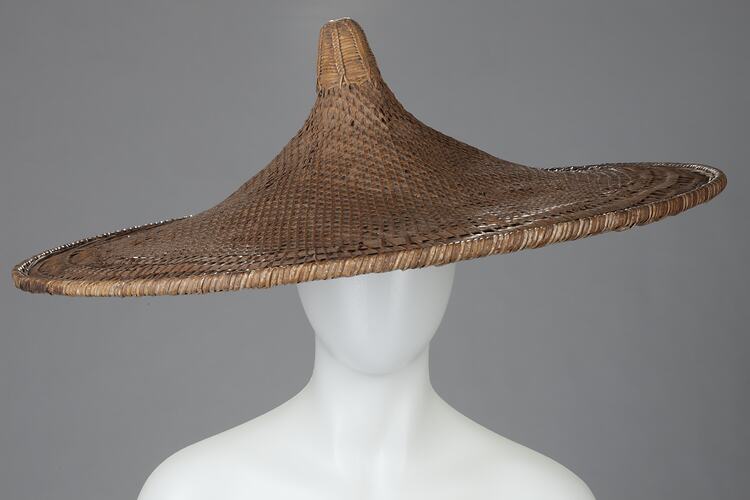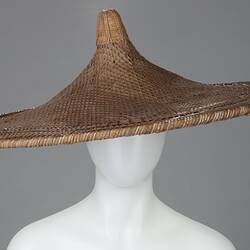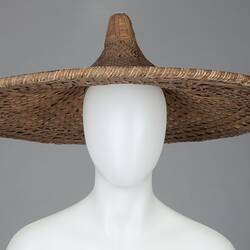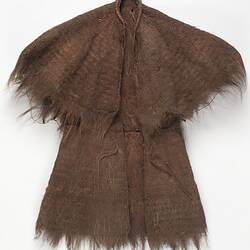Summary
Alternative Name(s): Straw Hat
Wide brimmed conical-shaped hat, made from cane and other vegetable matter. This hat, together with the related basket (SH 90.659) and Chinese field cape (SH 90.661), had been in possession of a family who occupied the same property for four generations at Smeaton, Victoria. This style of hat has been commonly worn in many countries across Asia for centuries and is used primarily as protection from the sun and rain. When made of straw or matting, it can be dipped in water and worn as an impromptu evaporative-cooling device.
This style of hat is also commonly referred to as a 'coolie' hat. However, the term 'coolie' was used to describe indentured labourers brought to Australia and other countries often against the will, and the word has historically derrogatory connotations, often used as a racial slur.
Hats of this particular style have been attributed to the Canton district of Guangdong China and reportedly worn by Chinese labour migrants moving and working around South-east Asia and further abroad. Constructed from bamboo strips, this hat has the characteristic plaited cap on the peak of the crown, black oiled paper lining providing water resistance and gilded paper inserted under the lattice frame for decoration. This hat has a copper-zinc alloy metal leaf inserted in three areas along the brim.
The hat most likely arrived in Australia during the Chinese immigration of the Gold Rush Era. Mining attracted Chinese migration during the 1850s with the first arrival reported in 1848 and majority of migrants came from the fertile farming plains of the Canton Delta region of Guangdong. Large scale migrations were in decline by 1880 as mining work ceased and while many Chinese migrants returned home, those remaining returned to agricultural pursuits, general labourers and market gardeners.
Physical Description
Wide brimmed 'coolie' type hat, made from cane and other vegetable matter. The hat is almost flat, rising to a sharply pointed peak at the centre. Rim firm, as if containing wood and bound tightly with cane; otherwise open weave, with a black-coloured paper-like backing visible. Underneath, the outer layer is woven principally from a heavier cane and lined with elongated, pale-coloured leaves (unidentifiable species- probably not Victorian). A finely woven inner rim would accommodate a head of 46cm circumference comfortable. Black backing appears to have been moulded to shape of hat.
More Information
-
Collecting Areas
Migration & Cultural Diversity, Home & Community, Sustainable Futures, Working Life & Trades, Clothing & Textiles
-
Acquisition Information
Purchase
-
Date Used
1855-1865
A former Director of the Museum of Chinese-Australian History in Melbourne dated the related field coat to circa1860, so the hat may be of a similar age. -
Classification
-
Category
-
Discipline
-
Type of item
-
Overall Dimensions
70 cm (Length), 22 cm (Height)
-
Exhibition Collection Management
700 mm (Length), 220 mm (Height)
-
References
See supplementary file for photograph of similar hat, dated early to mid 19th century.
-
Keywords
Chinese Communities, Chinese Immigration, Cultural Traditions, Rural Industry, Working Life




